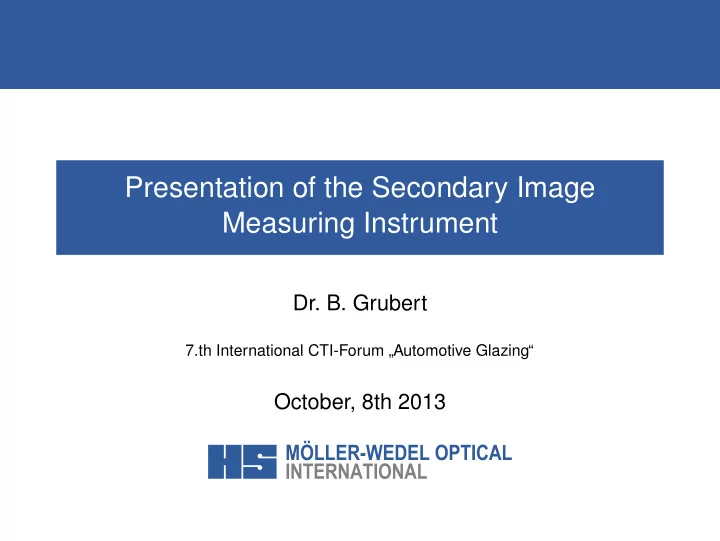

Presentation of the Secondary Image Measuring Instrument Dr. B. Grubert 7.th International CTI-Forum ”Automotive Glazing“ October, 8th 2013
Overview 1 Introduction to M ¨ OLLER-WEDEL OPTICAL GmbH 2 Causes and properties of the secondary image 3 Presentation of the laser-based measurement method 4 Comparison with the method according to ECE R43
Introduction to M ¨ OLLER-WEDEL OPTICAL GmbH Established 2000 as independent subsidiary of M ¨ OLLER-WEDEL GmbH Located: Wedel near Hamburg Mid-size company Member of the Swiss based HAAG-STREIT Holding AG Main products: Optical measuring and testing instruments
Appearance of the Secondary Image Double image with 6 arcmin secondary image angle separation.
Limits for Secondary Image Angle Separation Investigations showed that a separation below 10 arcsec are not recognised as annoying. According to the regulation ECE R43 the largest permissible value is 15 arcmin for area A and 25 arcmin for area B.
Secondary Images in Windshields Caused by Wedge The secondary images are caused by internal reflections in the windshield.
Secondary Images in Windshields Caused by Wedge The secondary image angle is the angle between primary and secondary image beam.
Calculation of the Secondary Image Angle Separation for Wedges � n 2 − sin θ 2 ǫ ≈ 2 α cos θ The amount of secondary image angle ǫ increases with increasing internal wedge angle α of the windshield, increases with increasing tilting angle θ of the windshield, increases with increasing refractive index n of the windshield material.
Secondary Images in Windshields Caused by Curvature
Calculation of the Secondary Image Angle Separation for Curvature ǫ ≈ 2 t tan arcsin sin θ n 3438 arcmin R The amount of secondary image angle ǫ decreases with increasing radius of curvature R of the windshield, increases with increasing angle of incidence θ on the windshield, increases with increasing thickness t of the windshield, decreases with increasing refractive index n of the windshield material.
Measurement Principle of the Secondary Image Angle Measuring Instrument
Image of Camera with Linear Sensitivity Secondary image not visible.
Brightness Ratio Primary to Secondary Image The primary image is usually 50 ∼ 100 times brighter than the secondary for incidence angles 50 ◦ ∼ 70 ◦ . → for a camera with 8-bit resolution depth the brightness of the secondary image is only 3 to 5, when the primary image has maximum brightness (255).
Image of Camera with Linear Sensitivity (Overmodulated) Primary image is strongly overmodulated in order to make secondary image visible
Image of Camera with Logarithmic Sensitivity Primary and secondary image are visible.
Polarisation of the Secondary Image The secondary image is predominantly linearly polarised in the perpendicular plane for incidence angles ∼ 60 ◦ ( ∼ Brewster angle). → The contrast between primary and secondary image can be improved by a factor of 2 when using linearly polarised illumination instead of non-polarised.
Illumination with linearly polarised light — parallel direction Secondary image not visible.
Secondary Image Angle Measuring Instrument
Features of the S econdary I mage A ngle M easurement ( SIAM )-Instrument Instrument is based on a proven set-up used at VW. No disturbance by local refractive index and power variations due to small diameter of the test beam. Easy and fast set-up of the instrument. Laser is eyesafe (laser safety class 2). Measurement value is independent of the distance between laser, windshield and telescope. Measuring range: 68 arcmin × 50 arcmin. Measurement uncertainty: better than 0.5 arcmin Objective measurement results due to PC-based image evaluation software.
Features of the Evaluation Software Real-time evaluation with 25 Hz frame rate. Automatic brightness control. Evaluation according to ECE R43. Display of the double image angle with magnitude ( ǫ ) and direction ( ϕ ). Use of predefined customisable measurement templates. Generation of protocol (PDF or ODT). Export of measurement results to spreadsheet software (CSV-format).
Windshield View of the Software
Live-Image View of the Software
Protocol View of the Software
Sketch of the Set-Up for Conformity Check According to ECE R43 Laser Folding3Mirror Telescope3with3Camera 120° 30´ 60° ° 0 20´ 5 3 1 0 ° 10´ 30´ 20´ 10´ 10´ 20´ 30´ 10´ 2 ° 0 1 3 0 20´ 3 ° 240° 300° 30´ Test Wedge 12,6S33330° Double3Collimator Beam- Beam- Telescope3with3Camera Splitter Splitter Cube Cube
Photograph of the Set-Up for Conformity Check According to ECE R43
Camera Image from the Set-Up According to ECE R43
Results for Magnitude of Secondary Image Angle
Results for Direction of Secondary Image Angle
Summary 1 The secondary image is predominantly linearly polarised. 2 By using a camera with logarithmic sensitivity and linear polarised illumination the visibility of the secondary image is strongly improved. 3 Automatic real-time evaluation allows objective measurement of the secondary image angle separation. 4 Evaluation is according to ECE R43.
Recommend
More recommend